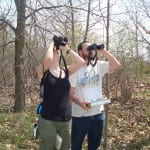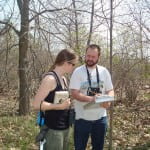Finally, spring migration has picked up the pace in bringing Point au Sable some new migratory birds! Right along the shoreline, we observed two Greater Yellowlegs (season’s first!), Killdeer, Barn Swallows, Northern Rough-winged Swallows, Tree Swallows, and Purple Martins. A few Common Goldeneyes and Scaup were still foraging offshore along withCaspian Terns, American White Pelicans, Double-creasted Cormorant, Herring Gulls, and Canada Geese.
Of particular interest, we had a number of season’s first species including: Blue-winged Warbler, Golden-winged Warbler, Blackburnian Warbler, Northern Parula, Yellow Warbler, Common Yellowthroat Warbler, Nashville Warbler, Rose-breasted Grosbeak, Gray Catbird, Warbling Vireo, and Baltimore Oriole.
In addition to these new migrants, we also observed several other species that continue to inhabit the beautiful Point au Sable: Black-throated Green Warbler, Yellow-rumped Warbler (in large numbers), Palm Warbler, Blue-gray Gnatcatcher, House Wren, Ruby-crowned Kinglet, Blue Jay, Chipping Sparrow, Song Sparrow, White-throated Sparrow, American Robin, Red-winged Blackbird, White-breasted Nuthatch, Red-breasted Nuthatch, American Goldfinch, Black-capped Chickadee, Downy Woodpecker, and Northern Cardinal. We had quite a day, totaling 38 species.
Observers: Erin Gnass, Nick Walton, Ashley Fehrenbach, and Kari Hagenow












